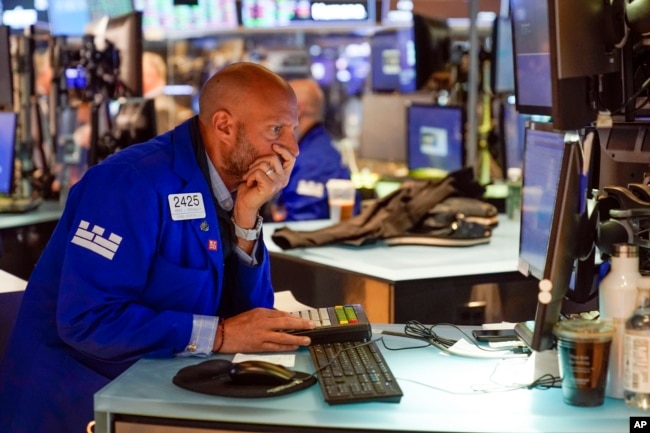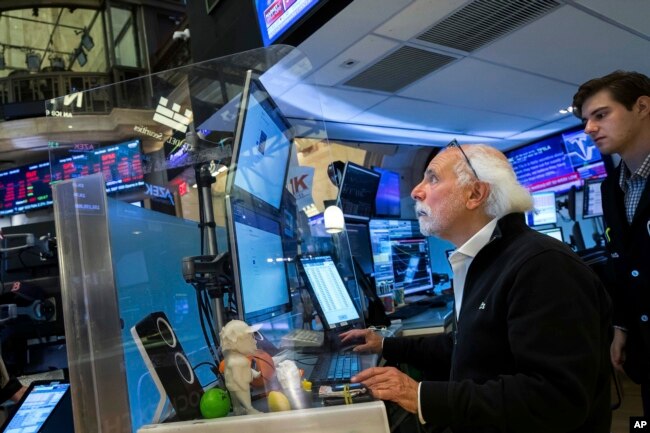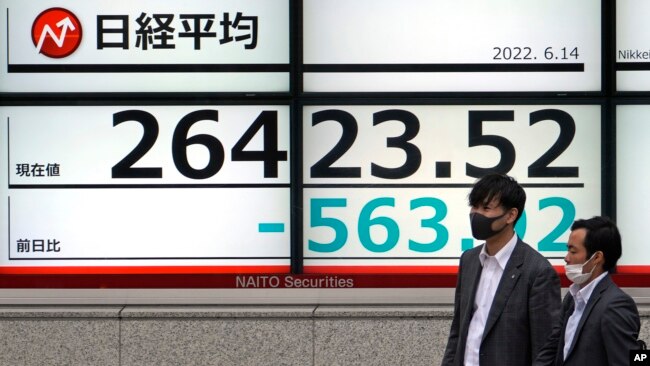ベアマーケットとは?
ブルームバーグの株価解説は、????だらけですが、この記事は勉強教材とあって、理解できる範囲でした、安堵!!
VOAの良いところは、旬なニュースとともに、満遍なくあらゆる分野の単語・表現を学べるところです。
VOAで今日も英語を学びましょう!!
’ベアマーケット’とは何か? (和訳)
What Is a 'Bear Market?'
June 15,2022
米国株式市場の主要指標であるS&P500指数は、月曜日に3.9%下落しました。これは、1月上旬につけた直近の高値から約22%下落したことを意味します。
ある指数が直近の高値から20%以上下落した状態が続くと、投資家はそれを弱気相場と呼びます。
熊は通常、冬の間は眠っていなす、いわゆる冬眠しています。ですから、クマは撤退する市場の象徴なのだ、とサム・ストボール氏は言います。彼は、市場調査会社CFRAのトップインベストメントエキスパートです。
投資家は、株式市場の上昇をブル・マーケットと呼びますが、それは雄牛が前進するからだとストバル氏は説明しています。
Dow Jones Industrial Average ダウ・ジョーンズ工業株価平均(ダウ平均株価)やナスダックなど、米国の他の主要な市場指数はいずれも下落しました。デジタルマネーの一種であるビットコインは、月曜日に23,000ドルを割り込みました。昨年末の1ビットコインの約6万8000ドルから下落しました。
※Dow Jones Industrial Average :アメリカのダウ・ジョーンズ社が発表する工業株30銘柄を対象とした平均株価指数で、NYダウ工業株30種やNYダウとも呼ばれています。
1896年に12種平均として作成、1928年10月1日からは30種平均として公表しており、株式市場動向や世界経済の方向性を考える上で欠かせない、アメリカを代表する株式市場の重要な指標として活用されています。(金融・証券用語集より)
火曜日、株式市場の指数はヨーロッパとアジアで全般的に下降しました。投資家は、インフレ、高金利、中国経済の減速、ウクライナ戦争などを懸念しています。
投資家は何を心配しているのか?
投資家は、米連邦準備制度理事会(FRB)がインフレ率の上昇を抑制するために金利を大幅に引き上げなければならないことを懸念しています。米国の中央銀行は、銀行に影響を与え、他の金利に影響を与える重要な金利をコントロールしています。
金利を上げると、お金を借りるコストが高くなるため、景気が悪くなります。リスクは、連邦準備制度が金利を上げすぎたり、早すぎたりすると、景気後退を引き起こす可能性があることです。
イングランド銀行を含む他の中央銀行も同様に金利を引き上げています。欧州中央銀行は、来月と9月に利上げを行うと発表しました。
先月、米連邦準備制度理事会は、インフレが過去40年間で最も高い水準にあることから、さらなる利上げが行われることを示唆しました。
ロシアのウクライナ戦争は、石油と食料のコストを上昇させ、物価に圧力をかけています。世界第2位の中国経済の減速は、金融問題への懸念に拍車をかけています。
景気後退を回避する必要があるのでしょうか?
たとえ連邦準備制度が景気を悪化させることなくインフレをコントロールできたとしても、金利の上昇は株価の下落圧力になります。
人々がお金を借りるのにもっとお金を払えば、買い控えが起こります。それは、企業が利益を小さくするか、損をすることを意味します。利益が減れば、企業の株価は下がります。
評論家は、景気後退の前に株価が高すぎたと言っています。パンデミック時に大きく上昇した大手テクノロジー株などは、その後値崩れしています。
ライアン・デトリック氏は、投資顧問業であるLPLファイナンシャルのチーフ・マーケット・エキスパートです。同氏によると、弱気相場とともに景気後退があった場合、株価はさらに10%下がる可能性があると言います。
弱気相場はどのくらい続くのか?
平均して、弱気相場はピークからトラフまで、つまり最高値から最安値まで13カ月かかっています。また、1940年代以降、損益分岐点まで戻るのに約27カ月かかっています。
この時期の弱気相場では、S&P500指数は平均33%下落しました。1945年以降で最も下落したのは2007-2009年の弱気相場で、S&P500は57%の下落。そして、最も長い弱気相場は61ヶ月続き、1942年3月に終了。この時、株価指数は60%の下落でした。
投資家はどのようにして弱気相場が終わったと判断するのでしょうか?
一般的に、投資家は安値から20%上昇し、少なくとも6カ月以上にわたって上昇を続けるかどうかを見ます。
しかし、2020年の弱気相場の後、株価は同年3月の安値から20パーセント上昇するのに3週間もかかりませんでした。
What Is a 'Bear Market?'
A major measure of the U.S. stock market, the S&P 500 Index, decreased 3.9 percent Monday. That means the index has fallen about 22 percent below its recent high in early January.
When an index falls 20 percent or more from a recent high for a continued period, investors call it a bear market.
Bears usually sleep, or hibernates, for the whole winter. So, bears represent a market that is withdrawing, said Sam Stovall. He is a top investment expert at CFRA, a market research business.
Investors call a rising stock market a bull market because bulls move forward, Stovall explained.
Other major market indexes in the U.S., including the Dow Jones Industrial Average and Nasdaq, all decreased. Bitcoin, a form of digital money, fell below $23,000 on Monday. That is down from nearly $68,000 for one bitcoin late last year.
On Tuesday, stock market indexes generally went down across Europe and Asia. Investors are worried over inflation, high interest rates, a slowdown in China’s economy and the war in Ukraine.
What is worrying investors?
Investors are concerned that the U.S. Federal Reserve will have to raise interest rates a lot to control rising inflation. The U.S. central bank controls an important interest rate that affects banks and influences other rates.
Increasing interest rates slow the economy by making it more costly to borrow money. The risk is the Federal Reserve could cause a recession if it raises rates too high or too quickly.
Other central banks, including the Bank of England, have been raising rates as well. The European Central Bank said it will do so next month and in September.
Last month, the Federal Reserve signaled that more rate increases are coming as inflation is at its highest level in 40 years.
Russia’s war in Ukraine has added pressure on prices by driving up the cost of oil and food. The slowdown of China’s economy, the world’s second largest, has added to concerns about financial issues.
Do we need to avoid a recession?
Even if the Federal Reserve could control inflation without a downturn in the economy, higher interest rates still put downward pressure on stock prices.
If people are paying more to borrow money, they buy fewer goods. It means businesses make smaller profits or lose money. Lower profits drive down a company’s stock price.
Critics are saying stock prices were too high before the downturn. Big technology stocks and others that gained a lot during the pandemic have since lost value.
Ryan Detrick is chief market expert at LPL Financial, an investment advisory business. He said if there were a recession along with a bear market, stock prices could decrease an additional 10 percent.
How long does a bear market last?
On average, bear markets have taken 13 months to go from peak to trough, or from the highest to the lowest points. They also have taken about 27 months to get back to the break-even point since the 1940s.
The S&P 500 index has fallen an average of 33 percent during bear markets during that period. The biggest decline since 1945 happened in the 2007-2009 bear market when the S&P 500 fell 57 percent. And the longest bear market lasted 61 months and ended in March 1942. It cut the index by 60 percent.
How do investors know when a bear market has ended?
Generally, investors look for a 20 percent gain from a low point and continued gains over at least a six-month period.
But after the 2020 bear market, it took less than three weeks for stocks to rise 20 percent from their low in March of that year.
Words in This Story
break-even –adj. when costs and income are equal; the point where a profit is possible, especially when talking about stocks


